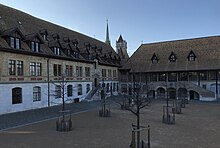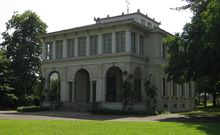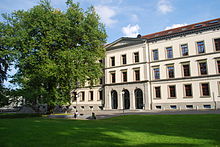High school maturity school
| High school maturity school (grammar school, canton school, college, college, grammar school , lycée , liceo ) |
|
|---|---|
| Country | Switzerland |
| Type of school (general) | secondary school |
| ISCED level | 3A |
| School board | Cantons |
| requirement | Secondary school diploma , entrance examination |
| Duration | 4 years (KZG) or 6 years (LZG) Levels : 11. – 14. or 9.-13. School level Standard age 16–19 or 13–18 |
| Graduation | Matura |
| Focus | numerous focal points |
|
|
|
A Matura school is in the educational system of Switzerland , a secondary school of secondary education sector that the university leads. There are secondary schools in all cantons. The term is used for the uniform designation of regulations. The individual schools are mostly referred to as a canton school (colloquially "Kanti") or as a grammar school (colloquially "Gymi", "Gymer"), less often as a middle school or college (colloquially "Kollegi"), in French-speaking cantons as a Gymnase (VD), Collège (GE, FR) or Lycée (NE), in Italian Switzerland as Liceo. The legal basis is the ordinance of the Federal Council that came into force in 1995 or the identical EDK regulations on the recognition of high school Matura certificates (MAV / MAR). Entrance to a Gymnasium Matura school takes place mostly in the last school year of the lower secondary level or after the secondary level I. The duration is usually four years. In some cantons, entry takes place after primary school; the duration is then generally six years (long-term high school).
history
Forerunners of the grammar schools in modern times were the monastery schools in the Middle Ages , which were run by a church institution and mainly served the training of prospective priests. In Protestant areas, with the Reformation in the 16th century, these schools were often transformed into Latin schools , the supervision of which switched to the sovereigns or the city councils. The main goal of school education remained the acquisition of Latin, and increasingly also Greek, language skills for reading the Bible. The designation as grammar school was common in the early modern period for both Protestant and Catholic ( Jesuit school ) learned schools that qualified for study .
There were several such schools in what is now Switzerland. Flade in St. Gallen is considered to be one of the oldest schools in the German-speaking world. It was probably founded at the beginning of the 8th century as a monastery school with an internal and external school, then closed in 1805 and in 1808/1809 as a “Catholic high school. Foundation ”and“ Citizens' School ”reopened. Since the founding of the canton school on Burggraben as a secondary school.
The former monastery school and today's collegiate school in Einsiedeln was founded in the second half of the 10th century and became a grammar school in 1839 and a federally recognized Matura school in 1872. The former monastery school and today's monastery school Engelberg was founded in the second half of the 12th century and has been a monastery school since 1851. The Collège St-Michel in Friborg, founded in 1582 by Pope Gregory XIII , can also look back on a very long tradition . The grammar school on Münsterplatz in Basel already existed as the bishop's Latin school and became a grammar school as early as 1589.
Many grammar schools were founded in the 19th century. The Leonhard grammar school in Basel was founded in 1813 as a daughter school. The canton school in Zurich was founded in 1833 and moved into its first domicile in 1842 at Rämistrasse 59 in a magnificent new building by Gustav Albert Wegmann. The Kirchenfeld grammar school in Bern was founded as a literary school in 1834 and moved into the neoclassical-style schoolhouse in the Kirchenfeld district in 1926.
Basics
aims
The aim of the Matura schools is to impart basic knowledge to high school students and to promote intellectual openness and the ability to make independent judgments. The degree, the Matura (also Matura) is a prerequisite for a university degree. Intellect, personal development, knowledge acquisition and the use of information technology are promoted.
admission
Each canton determines the conditions of admission independently. In more than half of the cantons, the transfer to a high school with very good results at the lower secondary level takes place without an entrance examination and by means of experience grades and assessments by teachers. In the other cantons, there is also a written and oral entrance examination. The first semester of high school is considered a probationary period.
Subjects and curriculum
The training in a matura school usually lasts 4 years. The levels were called Quarta, Tertia, Seconda and Prima in some cantons.
The teaching subjects are divided into basic subjects, main subjects and supplementary subjects (and any optional subjects). The students are taught in seven basic subjects, one major and one supplementary subject. Then there is the Matura thesis . The time proportion of the subjects is as follows:
- Basic subjects - languages: 30-40%
- Basic subjects - mathematics and natural sciences: 20-30%
- Basic subjects - humanities and social sciences: 10–20%
- Basic subjects - art: 5–10%
- Major subject, supplementary subject, Matura thesis: 15-25%
The basic subjects are: the first language (German, French, Italian, but not Romansh), a second national language (German, French, Italian), a third language (a third national language, English or an old language), mathematics, natural sciences: biology, Chemistry and physics, humanities and social sciences: history, geography and an introduction to economics and law, artistic design and / or music
The main subject must be selected from the following 8 subjects or subject groups: ancient languages (Latin and / or Greek), a modern language (a third national language, English, Spanish or Russian), physics and applications of mathematics (PAM), biology and chemistry ( BC), economics and law (WR), philosophy / psychology / pedagogy (PPP), visual design (BG), music
The supplementary subject must be selected from the following 13 subjects or subject groups: physics , chemistry , biology , applications of mathematics , history , geography , philosophy , religious studies , economics and law , pedagogy / psychology, artistic design , music , sport . From the 2008/2009 school year, computer science can now also be taken as a supplementary subject according to the partially revised MAR .
The Matura thesis is an independently written, pre-scientific work. The grade is noted in the Matura certificate.
Faculty
education
The training for the title of "Dipl. Teacher for Matura schools (EDK)" is based on the following legal principles: the regulations of Switzerland. Conference of the kt. Educational directors (EDK) on the recognition of teaching diplomas for Matura schools from June 4, 1998, and the EDK guidelines for the implementation of the Bologna Declaration at universities of applied sciences and colleges of education from December 5, 2002. The prerequisite for teaching qualification is usually a university Master's degree in one or two subjects - with the exception of music and visual design. The course can already be started after the Bachelor's degree. The course includes courses on general pedagogy and didactics, subject didactics and practical training components (school internships). It is offered by the following institutions: Universities of Education in Basel, Bern, Lucerne and the Canton of Thurgau, Universities of Friborg and Zurich, ETH Zurich, ZHdK Zurich (music, visual design) and the University of St. Gallen (business and law).
society
There are several thousand high school teachers in Switzerland. Your interests are represented by the Association of Swiss Gymnasium Teachers (VSG). The association is a member of the umbrella association for teachers in Switzerland and has over 4,000 members. The club magazine is the Helveticum grammar school .
Student body
Every year since 2006, around 70,000 pupils have been enrolled at Swiss grammar schools. Since the mid-1990s, the proportion of young women has been higher than that of young men; In 2018 it was 57%.
The student body is represented by student organizations. The student organizations are united in the umbrella organization Union of Student Organizations CH / FL .
Matura rate
The percentage of young people of a given year who achieve a Matura is known as the Matura quota. The differences in the maturity rate between the cantons are large. At the beginning of the 20th century, the Matura rate was 2%. By the end of the century, especially since the 1950s and 1970s, it had risen to around 18%. In the first two decades it rose to 21.5%. The question of how high the maturity quota should be is repeatedly debated in the media.
List of all high school Matura schools
There are a total of around 150 high school Matura schools in Switzerland, one in Liechtenstein and seven Swiss schools abroad .
Lake Geneva Region (Région lémanique)

- Geneva: List of high schools in the Canton of Geneva
- Vaud: List of high schools in the canton of Vaud
- Valais: College Brig , Lycée-Collège cantonal de la Planta , Lycée-Collège cantonal des Creusets , Lycée-Collège de l'Abbaye
Espace Mittelland
- Jura: Lycée cantonal de Porrentruy, Lycée Saint-Charles
- Neuchâtel: Lycée Blaise-Cendrars, Lycée Denis-de-Rougemont, Lycée Jean-Piaget
- Friborg: Collège de Gambach , Collège du Sud , Collège Sainte-Croix , Collège St-Michel
- Bern: List of grammar schools in the canton of Bern

Northwestern Switzerland
- Basel-Stadt: List of grammar schools in the canton of Basel-Stadt
- Basel-Landschaft: Gymnasium Liestal , Gymnasium Münchenstein , Gymnasium Muttenz , Gymnasium Oberwil , Gymnasium Laufental-Thierstein
- Solothurn: Cantonal School Solothurn , Cantonal School Olten
- Aargau: List of canton schools in the canton of Aargau
Zurich
Central Switzerland
- Lucerne: List of canton schools in the canton of Lucerne
- Obwalden: Cantonal School Obwalden , Sports Middle School Engelberg , Stiftsschule Engelberg
- Nidwalden: College of St. Fidelis
- Schwyz: List of canton schools in the canton of Schwyz
- Uri: Uri Cantonal Middle School
- Zug: Montana Institute, Menzingen KSM Cantonal School, Zug Cantonal School
Ticino (Ticino)
Liceo cantonale di Bellinzona, Liceo cantonale di Locarno, Liceo cantonale di Lugano 1, Liceo cantonale di Lugano 2, Liceo cantonale di Mendrisio
Eastern Switzerland
- St. Gallen: List of canton schools in the canton of St. Gallen
- Thurgau: List of canton schools in the canton of Thurgau
- Schaffhausen: Cantonal School Schaffhausen
- Glarus: Cantonal School Glarus
- Graubünden: Academia Engiadina , Bündner Kantonsschule , Protestant Middle School Schiers , Gymnasium & Boarding School , Kloster Disentis , High Alpine Institute Ftan , Lyceum Alpinum Zuoz , Swiss Alpine Middle School Davos , Sports Gymnasium Davos
- Appenzell Innerrhoden: St. Antonius High School
- Appenzell Ausserrhoden: Trogen Cantonal School
Liechtenstein
Swiss schools abroad
- Colegio Helvetia de Bogotá
- Escola Suiço-Brasileira de São Paulo
- Escuela Suiza de Barcelona
- RIS Swiss Section - German Language School Bangkok
- Swiss School Madrid
- Swiss School Milan
- Swiss School Rome
Web links
- State Secretariat for Education, Research and Innovation
- Ordinance of February 15, 1995 on the recognition of high school Matura certificates (Matura Recognition Ordinance, MAV)
- Swiss Conference of Directors of Education
- Swiss education server educa.ch
- Career counseling
- All high school Matura schools
Individual evidence
- ↑ https://bildungssystem.educa.ch/de/gymnasiale-maturitaetsschule-gymnasium
- ↑ https://www.berufsberatung.ch/dyn/show/1900?id=4906
- ↑ https://www.bfs.admin.ch/bfs/de/home/statistiken/bildung-wissenschaft.assetdetail.7586274.html
- ↑ Johannes Gruntz-Stoll: Maturität. In: Historical Lexicon of Switzerland . September 29, 2010 , accessed June 27, 2019 .




